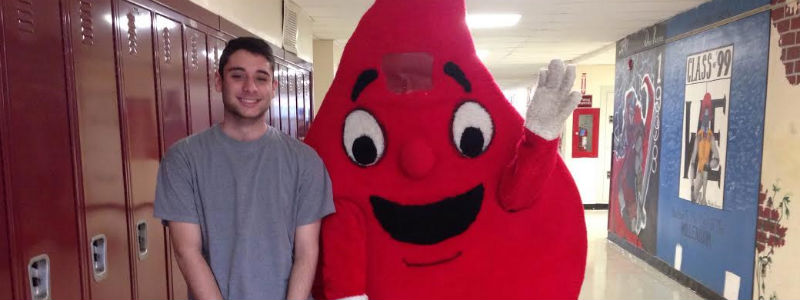Wessex bleeds success at blood drive
June 10, 2016
Junior Anthony Agrifolio with “Buddy,” the American Heart Association’s mascot.
By Grace Irwin ’18
Students eagerly volunteered in the American Heart Association’s annual blood drive on April 26, from 8 a.m. to 1 p.m. in the West Gym. Donors each gave one pint of blood, which will go to hospital patients in need of blood transfusions. Exceeding the goal of 64 donors, 66 successful donations were made, helping over 198 patients.
“This year proved to be the most successful one yet for the blood drive,” school nurse Ms. Frisch said, with 97 students volunteering. The group used up all of the supplies brought for the day’s work, turning away 15 volunteers and making for a busy morning. “We had nearly a hundred students walk in, which is way more than what we’ve had in previous years,” Ms. Frisch said. “It was excellent.”
Anyone 16 or older that meets the weight requirement is a viable donor. “I’m a healthy person and if I can help people who are less healthy than me, why not?” said junior Zoe Stern, who was a donator. “One pint of blood is able to help up to three people and can save a life.”
For most students, the entire process of drawing blood only lasted 5 to 10 minutes. However, for those of the rare blood type O, the universal donor, the process took 20 to 30 minutes. Because of this, the blood taken from type O donors, was separated into red blood cells and plasma, looking a yellow color in its designated bag.
“When the plasma started leaving, my lips and mouth felt really cold. It was kind of like in those gum commercials when they put the gum in their mouths and act surprised by the coolness,” senior Danny Calix said.
When finished giving blood, donors were asked to sit down on mats, eat snacks, and drink fluids to give their bodies the chance to recover. Once they felt they were ready to go on with the rest of their school day, they were given a sticker to show they participated in the drive and were sent back to their designated classrooms to go on with the rest of their day.
According to Gabe Riel, an AHA employee since 2008, the group gets on average 10 donors a day on a normal schedule. After the day’s donations are collected, each blood bag is packaged up and sent off to a laboratory in Philadelphia, where the blood is tested for different diseases. Once verified as clean, the blood is sent to hospitals throughout New Jersey and Philadelphia.
“It is important that the blood is checked and rechecked for possible diseases or other components that could make it unusable. Our goal is to help patients, not hurt them,” Riel said.
The American Heart Association, founded in 1924, includes up to 22.5 million donors and supporters to date. By conducting research, providing CPR training, educating lawyers and lawmakers, and collecting blood, the AHA works to raise awareness and lower the amount of deaths by heart disease per year. According to their website’s homepage, by 2020, the organization hopes to lower the amount of Americans with heart disease by 20 percent.


